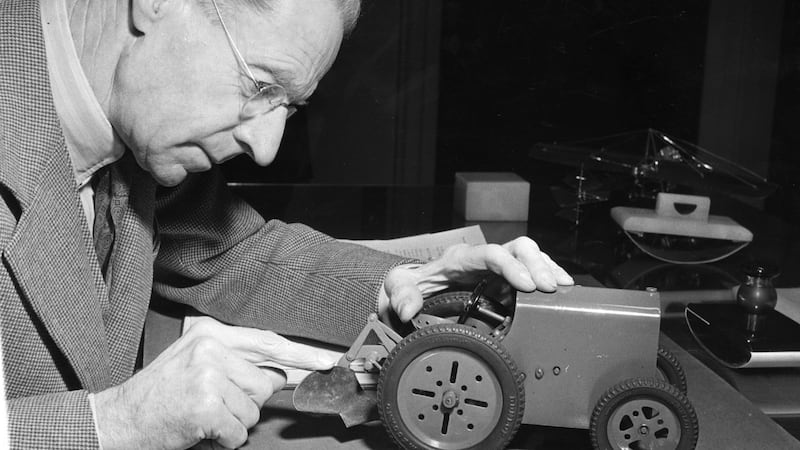In the 1950s, a couple from Malin Head were well known for taking “the Cadillac” from their shed and driving into Derry.
It would have been an incongruous image if not for the fact their Cadillac was really a Little Grey Ferguson tractor, ubiquitous on Irish farms if not quite in the cities. Even still, deadpans historian Mervyn Watson, "there are a lot of local stories like that".
The Little Grey Fergie was once the Cadillac of rural Ireland. Such affectionate tales were indicative of the impact the machines had on Irish agriculture and, by extension, society. Today they are commonly found on working farms and trundling along narrow country roads.

This year is the 70th anniversary of the “Little Grey”, or TE20, Ferguson. If 2016 marks the centenary of the Rising, this was a smaller, less trumpeted but valuable revolution.
"It put Irish agriculture on wheels as it were. It changed the whole face of agriculture in Ireland," explains Albert Walker, one of the many farmers preparing to mark this year's celebratory events. "People built up a great affinity with them. There was a great love for them."
Like so many enthusiasts, Walker can tell you the history of the machine as it evolved from the practical imagination of creator Harry Ferguson to the production lines of English factories and eventually to till the soil of farms across the world.
Ferguson – a farmer’s son but also a bicycle mechanic and pioneer of aviation in Ireland – wasn’t a farmer by heart. “He was more mechanically minded and it instilled in his mind whether there could be a mechanical way to ease the work on a farmer,” explains Walker.
In the ascendency
In the aftermath of the first World War, the Co Down engineer was appointed by the Department of Agriculture to demonstrate modern ploughing to Irish farmers. The tractor was in the ascendency: their numbers grew from 70 in 1917 to 640 the following year (the number for the entire island would climb to 31,000 by 1960).
Realising the early method of towing ploughs by chain or rope was both inefficient and dangerous – they would topple after striking something in the ground like a tree root – Ferguson set out to re-imagine their design.
“They were that dangerous that people were being killed,” says Walker. “Considering that the number of tractors on the ground was relatively small, it was a common enough occurrence.”
Ferguson conceived the industry-changing “three point linkage”, a system which remains the fundamental engineering of modern-day tillage. The system mounted ploughs with the help of hydraulics, rather than merely towing them, and made the process robust and safe.
Initially there wasn’t much interest in Ferguson’s design, and so he self-produced the prototype “Black Tractor” in 1933.
Following a deal with David Brown in Huddersfield, the Model A Fergusons appeared in 1936. By 1939, 1,300 had been produced.
Ferguson then decided to go to America where he would develop a bigger, more powerful machine.
In 1938, he demonstrated this new tractor to Henry Ford who immediately appreciated its potential. Together they produced 10,000 by the end of 1939. These were the forerunners to the Little Grey Ferguson.
The relationship with Henry Ford eventually soured, and Ferguson decided to switch his tractor production to England.
In the aftermath of the second World War, there were numerous vacant munitions factories, and Ferguson struck a deal with John Black of the Standard Motor Company which led to the development of the Little Grey Fergie.
About 300 were produced in 1946 before going into full production the following year for both the domestic and foreign markets.
By 1956, when they had stopped making them, there were more than half a million all over the world, even reaching the collective soviet farms behind the Iron Curtain.
“It mechanised farms. That was the way people at the time in the early 1950s got into mechanisation, through the Ferguson,” explains Walker. His own Little Grey Fergie is still paying back on its investment today, dragging materials around his yard in Co Cavan.
But it is not simply a story of Irish sentiment. Mervyn Watson, author of several texts on Irish agricultural history, says the value of the Ferguson is held fundamentally in its three-point-linkage.
“Horse-drawn ploughs were a major implement but after the war there was a huge drive on both sides of the Border to modernise. The war had taken a lot of males out of the picture, and work needed to be done,” he says.
“Its mechanisation was the key thing. You have to remember Ireland and England were coming out of a major war [period] and there was a shortage of everything.”
Even then it wasn't until after the late 1950s that tractors begin to overtake horses as the main source of draft on the land. It was the same era, Mervyn points out, in which Elvis Presley, Marilyn Monroe and rock'n'roll were reshaping society.
Ploughing competitions were growing in popularity. Horses were seen as old-fashioned yet kept on; theirs was a symbolic importance that tied them to the land and to heritage. Simultaneously, though, modern machinery became a mark of pride.
“It was a sort of status thing. Even small farmers wanted to have their tractors,” says Watson.
Today the Little Grey Fergie has taken the role of the ploughing horse, redundant in virtually every respect and yet still a fixture of Irish country life.
A number of events have been held by the Friends of Ferguson Heritage Organisation throughout the island of Ireland this year to commemorate both the 70th anniversary of the “Grey Fergie” and the 80th anniversary of the Ferguson Brown











